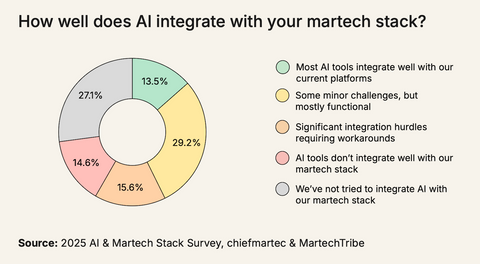Trend #1: From SERPs to “Answer Pages”
What’s Changing
Massive emergence of AI-generated summaries
In 2025, the share of queries triggering a Google AI Overview more than doubled (≈6.5% → ≈13.1% within three months at the beginning of 2025), especially for informational searches (≈88%). These AI-generated blocks deliver direct answers — displayed above the organic results.
Measurable decline in clicks
When an AI summary appears, users click significantly less on traditional links (≈8% of visits vs ≈15% without a summary). Several publisher analyses report drops of 1% to 25% in Google traffic — sometimes more depending on the niche.
Regulatory and publisher pressure
Antitrust complaints (in the EU) and collective actions from media groups (for instance, in Italy) are challenging the impact of AI Overviews on value distribution and visibility.
Rise of alternative “answer engines”
Perplexity is rapidly expanding (tens of millions of active users and hundreds of millions of monthly queries), experimenting with revenue-sharing models for publishers. Bing/Copilot and other players are also integrating synthetic responses by default.
Why It’s Structurally Important for 2026
The paradigm is shifting from page ranking to answer aggregation and synthesis.
Attention (and clicks) now move upward — into the answer layer. Brands invisible within these AI blocks lose consideration opportunities before users even visit their websites.
Independent studies suggest CTR declines of 34–46% when AI summaries appear.
Best Practices
1. Structure content for synthesis
-
Build “hub” pages offering clear, concise answers to user questions. Include structured FAQs, featured snippets (definitions, formulas, checklists).
-
Provide verifiable data (cited sources, dated figures, methodologies) to maximize your likelihood of being cited, not merely scraped.
2. Target “answer-prone” queries
Prioritize informational intents where AI Overviews are statistically more frequent — in science, health, society, how-to searches, and comparative queries.
3. Measure differently
Track impressions without clicks, citation share within AI answers, and referral traffic from answer engines (Perplexity, AI Mode, etc.).
Trend #2: The Shift Toward Verifiable Authenticity
Context
Standardized provenance
Watermarking and detection tools
SynthID (from Google DeepMind) is expanding invisible watermarking across image, audio, video, and text. Google has also launched a public detection portal for images generated using its tools.
Platforms and media
YouTube and other major platforms have started labeling uploaded content as synthetic or authentic, while several publishers now use Content Credentials to verify original sources.
Implications for Brands
-
The risk of dilution (copies, hallucinations, deepfakes) is pushing brands to tag and document their proprietary assets.
-
The trust signal becomes a competitive differentiator: signed, traceable, auditable content (who shot, edited, or retouched it?).
-
Search engines and LLMs may favor content with clear provenance and verified authenticity.
Recommended Actions
1. Activate Content Credentials everywhere
3. Make proof of authenticity “human”
Publish behind-the-scenes content (shooting, editing, sourcing), create author pages (bio, expertise, social links), and attach methodology files to studies and infographics.
4. Connect proof ↔ performance
Tag credentialed content in analytics to compare LLM citation rates, watch time, and conversion against non-credentialed content.
Trend #3: AI Marketing Agents — From Demo to Production
Agentic platforms — enabling autonomous AI agents to operate, interact, make decisions, and take action within enterprise or software environments (rather than performing limited or reactive tasks) — are entering marketing stacks across planning, media buying, creative testing, and CRO.
2025 saw major announcements:
-
Salesforce Agentforce 360, for deploying enterprise-grade AI agents.
-
WPP × Google, to industrialize creative production and optimization via Gemini/Veo.
The IAB 2025 studies confirm that adoption is progressing but still in pilot mode — with data quality, security, and governance as key enablers for scalability.
Conclusion
2026 will likely mark a historic turning point in how brands become visible, credible, and valuable to their audiences.
This shift is not merely technological — it’s epistemological.
Marketing is moving away from the era of algorithmic ranking toward an era of informational trust — a landscape where every piece of data, image, or word must be traceable, contextualized, and authentic.
Marketing will no longer be about “convincing to exist,” but about existing to be cited.
In this new attention economy, the citation — whether human or generative — will be the most valuable form of conversion.
FAQ
Q1. How can I tell if my pages are “eligible” for AI answers
Monitor your informational queries (how-to, definitions, comparisons…). Studies from 2025 show these trigger AI Overviews most often.
Map your SERPs with and without AI responses and measure CTR impact.
Q2. Does GEO replace SEO?
Core SEO principles (content quality, structure, data hygiene) remain fundamental.
Q3. How can I “prove” authenticity without overcomplicating production?
Add a “Methodology / Sources” section to each study, and publish short behind-the-scenes clips.
Q4. Which KPIs should be tracked in the era of “answers”?
Beyond clicks:
-
Brand impressions (SERP + answer engines)
-
Citation rate within AI answers
-
Video watch time
-
Share of voice in “People also ask” / FAQs
-
Growth in branded queries
(Recommended approach according to recent GEO analyses.)

The Saas Advisor Team





